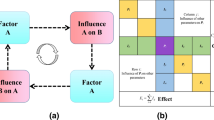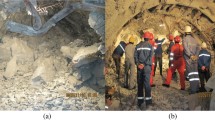Abstract
Comprehensively and reliably assessing the rock drillability is a vital prerequisite for guiding the rapid construction of pile foundation engineering. This paper studies rock drillability and its evaluation method. We established a grading standard of influencing factors by analyzing the factors that influence drilling, according to the physical–mechanical properties of rock and actual drilling characteristics. Based on the hierarchy of these factors, a two-layer fuzzy comprehensive evaluation model is proposed. The analytic hierarchy process (AHP) is used to determine the weight of each stage factor, the fuzzy sets method is used to determine the membership function, and the influencing factors are ranked. This model was applied to the construction of the 2nd Humen Bridge Project. The results show that the physical properties of rock have the greatest impact on drillability, and the weight is 0.443. The content of quartz and iron in the physical properties is the prime factor affecting the rock drillability. The results of assessment and calculation are in line with the site conditions, which validate the feasibility and practicability of the fuzzy comprehensive evaluation (FCE) method for the rock drillability established in this paper. This study can also serve as guidelines for other rock-drilling engineering.









Similar content being viewed by others
Data availability
All data generated or analyzed during this study are included in this published article.
Code availability
No code is involved in this article.
References
Akün ME, Karpuz C (2005) Drillability studies of surface-set diamond drilling in Zonguldak region sandstones from Turkey. Int J Rock Mech Min Sci 42:473–479
Aligholi S, Lashkaripour GR, Ghafoori M, Azali ST (2017) Evaluating the relationships between NTNU/SINTEF drillability indices with index properties and petrographic data of hard igneous rocks. Rock Mech Rock Eng 50:2929–2953
Altindag R (2010) Assessment of some brittleness indexes in rock-drilling efficiency. Rock Mech Rock Eng 43:361–370
ASTM D3967–16 (2016) Standard test method for splitting tensile strength of intact rock core specimens. ASTM International, West Conshohocken
ASTM D5731–16 (2016) Standard test method for determination of the point load strength index of rock and application to rock strength classifications. ASTM International, West Conshohocken
ASTM D5878–19 (2019) Standard guides for using rock-mass classification systems for engineering purposes. ASTM International, West Conshohocken
Ataei M, KaKaie R, Ghavidel M, Saeidi O (2015) Drilling rate prediction of an open pit mine using the rock mass drillability index. Int J Rock Mech Min Sci 73:130–138
Capik M, Yilmaz AO (2017) Correlation between Cerchar abrasivity index, rock properties, and drill bit lifetime. Arab J Geosci 10:15
Capik M, Yilmaz AO, Yasar S (2017) Relationships between the drilling rate index and physicomechanical rock properties. Bull Eng Geol Environ 76:253–261
Chen JH, Feng Y, Zeng YJ, Han YN, Wang Y, Niu CC (2017) Continuous rock drillability measurements using scratch tests. J Pet Sci Eng 159:783–790
Fairhurst CE, Hudson JA (1993) Draft ISRM suggested method for the complete stress train curve for the intact rock in uniaxial compression. Int J Rock Mech Min Sci 36:281–289
Hamidi JK, Shahriar K, Rezai B, Bejari H (2010) Application of fuzzy set theory to rock engineering classification systems: An illustration of the rock mass excavability index. Rock Mech Rock Eng 43:335–350
Hoseinie SH, Aghababaei H, Pourrahimian Y (2008) Development of a new classification system for assessing of rock mass drillability index (RDi). Int J Rock Mech Min Sci 45:1–10
Hoseinie SH, Ataei M, Osanloo M (2009) A new classification system for evaluating rock penetrability. Int J Rock Mech Min Sci 46:1329–1340
Hoseinie SH, Ataei M, Mikaiel R (2012) Comparison of some rock hardness scales applied in drillability studies. Arab J Sci Eng 37:1451–1458
Iphar M, Goktan RM (2006) An application of fuzzy sets to the Diggability Index Rating Method for surface mine equipment selection. Int J Rock Mech Min Sci 43:253–266
ISRM (2007) The complete ISRM suggested methods for rock characterization, testing and monitoring: 1974–2006. In: R Ulusay, JA Hudson (eds.) Compilation Arranged by The ISRM Turkish National Group, Ankara, Turkey
Kahraman S (1999) Rotary and percussive drilling prediction using regression analysis. Int J Rock Mech Min Sci 36:981–989
Kahraman S, Balcı C, Yazıcı S, Bilgin N (2000) Prediction of the penetration rate of rotary blast hole drills using a new drillability index. Int J Rock Mech Min Sci 37:729–723
Kahraman S, Bilgin N, Feridunoglu C (2003) Dominant rock properties affecting the penetration rate of percussive drills. Int J Rock Mech Min Sci 40:711–723
Li JP, Duan LC, Li Q (2012) Application of fuzzy comprehensive evaluation method in rock drillability classification. Geol Sci Technol Inform (China) 31:127–130
Li G, Yang M, Meng YF, Liu HB, Han L, Zhou F, Zhang H (2016) The assessment of correlation between rock drillability and mechanical properties in the laboratory and in the field under different pressure conditions. J Nat Gas Sci Eng 30:405–413
Liu X, Ni CW, Zhang LY, Sheng K, Hong BN (2019) Durability assessment of lightweight cellular concrete in subgrade by the method of analytic hierarchy process combined with fuzzy comprehensive evaluation. Math Probl Eng 2019:1–10
Majeed Y, Bakar MZ, Butt IA (2020) Abrasivity evaluation for wear prediction of button drill bits using geotechnical rock properties. Bull Eng Geol Environ 79:767–787
Mao S, Shi XC, Meng YF, Chen P, Zhuo X, Wong LNY (2018) Experimental investigation of rock drillability for three rock types under varying wellbore pressure conditions. Rock Mech Rock Eng 51:2439–2445
Shad H, Sereshki F, Ataei M, Karamoozian M (2018) Prediction of rotary drilling penetration rate in iron ore oxides using rock engineering system. Int J Min Sci Technol 28:407–413
Singh TN, Gupta AR, Sain R (2006) A comparative analysis of cognitive systems for the prediction of drillability of rocks and wear factor. Geotech Geol Eng 24:299–312
Su YH, He MC, Sun XM (2007) Equivalent characteristic of membership function type in rock mass fuzzy classification. J Univ Sci Technol Beijing (China) 2007:670–675
Tanaino AS (2008) Rock drillability classification. Part II: Canonical representation of rock properties in the rock classification by fracture resistance. J Min Sci 44:600–615
Thuro K (1997) Drillability prediction: geological influences in hard rock drill and blast tunneling. Geol Rundsch 86:426–438
Tokiwa T, Tsusaka K, Aoyagi K (2018) Fracture characterization and rock mass damage induced by different excavation methods in the horonobe URL of Japan. Int J Civ Eng 16:371–381
Yarali O, Kahraman S (2011) The drillability assessment of rocks using the different brittleness values. Tunn Undergr Space Technol 26:406–414
Yarali O, Soyer E (2013) Assessment of relationships between drilling rate index and mechanical properties of rocks. Tunn Undergr Space Technol 33:46–53
Yenice H, Özdoğan MV, Özfirat MK (2018) A Sampling Study on rock properties affecting drilling rate index (DRI). J Afr Earth Sci 141:1–8
Yu BS, Zhang K, Niu GG, Xue XX (2021) Real-time rock strength determination based on rock drillability index and drilling specific energy: an experimental study. Bull Eng Geol Environ 80:3589–3603
Zhang X, Zhai YH, Xue CJ, Jiang TX (2011) A Study of the distribution of formation drillability. Pet Sci Technol 29:149–159
Zhang K, Hou RB, Zhang GH, Zhang GM, Zhang HQ (2016) Rock drillability assessment and lithology classification based on the operating parameters of a drifter: case study in a coal mine in China. Rock Mech Rock Eng 49:329–334
Funding
This study was funded by the National Natural Science Foundation of China (Grant No. 51609071) and the Fundamental Research Funds for the Central Universities (Grant No.B200202087, B200204032).
Author information
Authors and Affiliations
Contributions
All authors contributed to the study’s conception and design. Material preparation, data collection, and analysis were performed by Guisen Wang, Ke Sheng, and Xiaoxu Qian. The first draft of the manuscript was written by Guisen Wang. Writing—review and editing were performed by Xin Liu and Baoning Hong, and all authors commented on previous versions of the manuscript. All authors read and approved the final manuscript.
Corresponding author
Ethics declarations
Conflict of interest
The authors declare no competing interests.
Additional information
Responsible editor: Zeynal Abiddin Erguler
Rights and permissions
About this article
Cite this article
Wang, G., Liu, X., Hong, B. et al. Assessment of rock drillability by the method of analytic hierarchy process combined with fuzzy comprehensive evaluation. Arab J Geosci 15, 67 (2022). https://doi.org/10.1007/s12517-021-09270-x
Received:
Accepted:
Published:
DOI: https://doi.org/10.1007/s12517-021-09270-x




